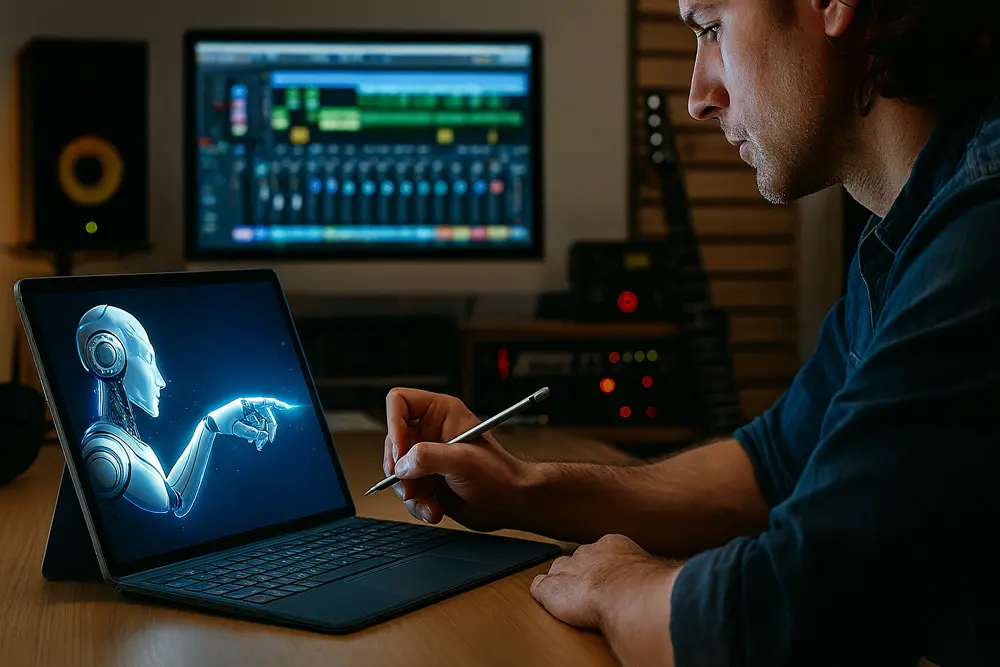Clarifying human vs AI contribution in co-writes and collaborations
by AiSongFix Staff | October, 13, 2025.

Split sheets have always been essential for maintaining transparency in songwriting collaborations, as they clearly define who wrote what, who owns what, and how royalties will be divided. However, when AI enters the creative process, things become complicated quickly.
Who gets credit when an algorithm generated part of the song? How do you handle ownership when AI isn't legally recognized as an author? Let's break down how to correctly complete a split sheet when AI is part of your songwriting process.
Traditionally, split sheets record the percentage of ownership each human contributor has in the composition and lyrics.
However, the U.S. Copyright Office made it clear in its 2023 AI Policy Guidance: "Only human-created material can qualify for copyright protection." That means AI-generated material, such as lyrics, melodies, or instrumental ideas created entirely by an algorithm, can't be listed as a copyright holder or co-writer.
However, that doesn't mean you can't use AI in your songwriting process. It just means you must clearly document what you contributed versus what was generated by AI.
Start by listing every human who contributed creatively to the song. That includes lyricists, composers, producers, or anyone who helped craft the melody, chord progression, or structure of the song. The AI system itself should not be listed as a co-writer. Why? Because it can't legally own or transfer rights. Instead, attribute the human who guided or edited the AI's output.
Example:
↓📁 Song Split Sheet | (PDF 108k)
A simple agreement for co-writers to clearly define each person's contributions and ownership percentages for a song.
Transparency is key. Under the “notes” or “comments” section, document how AI was used. Was it used to suggest chord progressions? Generate draft lyrics? Compose background melodies? This isn't a legal requirement, but it shows honesty in collaboration and helps avoid disputes later.
Example:
“Lyric draft generated using AI tool (Suno); writers manually revised and replaced 80% of content.”
This notation helps clarify that human authorship predominates, which is essential if you ever need to register the song with the Copyright Office.
↓📁 AI Lyric Checklist | (PDF 113k)
A practical tool to help you revise AI-generated lyrics so they sound more emotional, natural, and pitch-worthy.
The Copyright Office evaluates works “case by case,” focusing on the degree of human creative control. The more you edit, shape, or rewrite the AI's material, the stronger your claim to copyright protection. Make sure your split sheet and any accompanying notes reflect that your human contribution was substantial and final.
You might even include a separate document (like an AI Song Human Contribution Checklist) showing how the human collaborators refined and reinterpreted AI-generated material.
↓📁 AI Song Human Contribution Checklist | (PDF 155k)
Document the human input in your AI-assisted song for copyright protection, pitching, and professional validation.
Ownership should be divided only among human collaborators based on their creative contribution. Even if an AI tool provided 50% of the ideas, you can't assign a percentage to the AI itself. Instead, attribute ownership based on who made the creative decisions and final revisions.
Think of AI as a tool or software instrument. It's no different than a guitar or DAW plugin. The songwriter using the tool retains full authorship for the portions they control.
Keep screenshots, prompts, and session data from your AI tools. This provides clear evidence of how the AI was utilized and the subsequent changes made. It's not legally required, but it could help defend your claim if questions arise about originality.
↓📁 Song Creation Proof Log | (PDF 47k)
A single-song record sheet for documenting dates, collaborators, contributions, and revisions to help establish authorship and protect your rights.
When AI is involved, your split sheet should reflect transparency and human authorship.
AI can assist, but only humans can claim ownership. Treat AI as a collaborator's tool, not a collaborator itself, and your split sheet and your rights will hold up if ever challenged.
Need to humanize your AI song? We can help rewrite your lyrics, melody, or track to make it ready for copyright and pitching.
Country Demo Studio 🌐↗